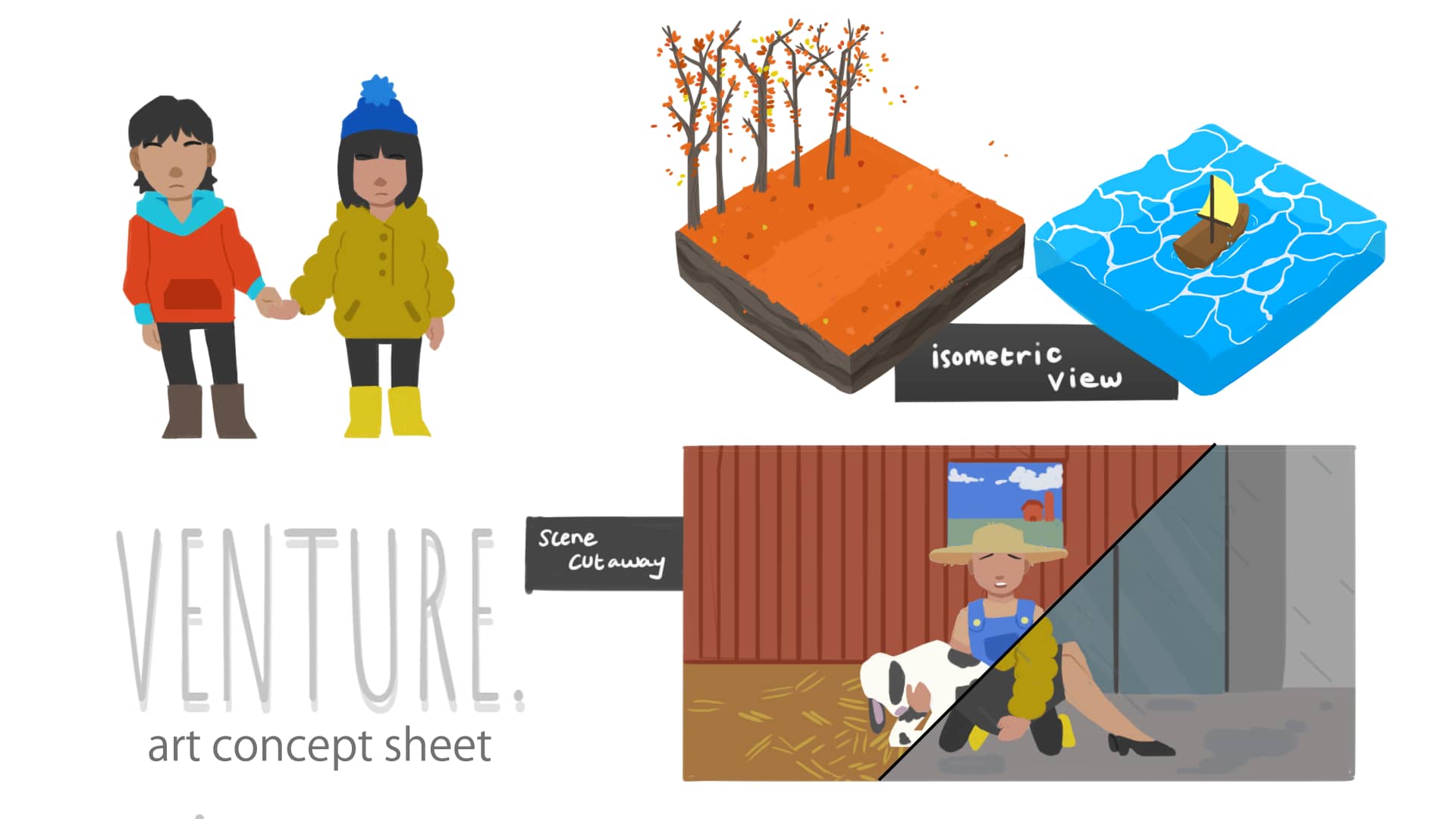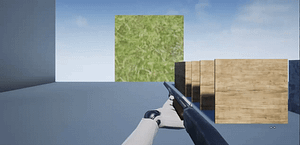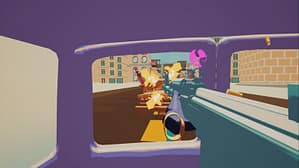Pressing the Start Button
It is high time that I started writing, or rather “pressing start” on a blog chronicling my ventures into the wonderful world of game design and development. . So hello there, reader! My name is Karl Lewis and I’m a Game Design student at Champlain College. I’m currently in my second semester of my junior year, which is both exciting and horrifying to think about at the same time (where did all that time go…?)! My main specialization in the vast realm of game design lies in systems design, but I am also specialized in sound design/implementation for games.
During the second semester of junior year at Champlain, all students in the 4 separate Game Studio program disciplines (Design, Programming, Art, and Production) come together to form teams and spend the semester making a “vertical slice” of any type of game they come up with. This class is called Game Production 2, and I am already 2 weeks into it. It’s been quite a lot of work so far, but I enjoy working on games so much that it has mostly been a super fun experience.
This section of my blog will cover the work that myself and my 4 fantastic teammates have been cooking up every week, with new entries coming every Thursday (probably…). So without further ado, I’ll get into what I’ve been up to for the past two weeks!
Rapid, and I mean RAPID Prototypes: Weeks 1-3
It is probably best to preface with a brief overview of the structure of my Production 2 class. On the first day, we came in with our teams (that had already been made last semester) to find out that the first three weeks of the class would be spent coming up with and prototyping 3 unique game concepts, one new prototype each week. In class the next week, we would present our concept and prototype in a semi-formal presentation and receive critique. Once these three weeks end (which is this coming Tuesday), each team picks from one of the three games they prototype and spends the rest of the semester in full production to deliver a vertical slice of the concept (note: a vertical slice is like a demo of everything in the game that the player can do and an example of the overall experience).
With week 3 of the rapid prototyping phase well underway (and much less stressful than the first two, since we’ve gotten into a good rhythm with the process now), I’m going to talk about what happened during the first two weeks in the remainder of this blog post and briefly touch upon what we’re doing for this coming deadline.
But first, I should talk about my teammates, because all 4 of them are awesome and I love working with them!
Emmett Friedrichs is the team’s other design major. He’s got a penchant for coming up with really interesting and fun game ideas and is a level & UI design wizard. He’s also got a great sense of humor and is generally a fantastic addition to any team, as I’ve worked with him on at least 5 other projects by now. @Emmett_Fried
Josh Grazda is our one and only programmer, and man is he good at what he does. He’s shown me some mind blowing stuff that I didn’t even know existed in Unity and has helped make our prototyping process extremely smooth. Also got a great sense of humor like Emmett. I worked with him once before during a game jam last semester when I was in Montreal, and I’m happy to be working with him again! @Jagman926
Austin Roorda is our producer and is an organizational genius. He excels at keeping our team on track and organized at all times. One time we attempted to start a meeting while he was running a bit late due to an event and we just ended up fooling around and memeing til he got there to get us on track. As with the rest of the team, he’s a great guy to hang out with and has a great sense of humor. I’ve only worked with him once previously on the same game jam game that I did with Josh and Emmett in Montreal. I would definitely want to have him as a producer again in the future! @roorda_austin
Riley Morrissey is our only artist, but that’s perfectly okay, because she’s truly fantastic at what she does. All of the conceptual art she’s made for these rapid prototypes has been beautiful and fit with the vision of the game’s design. She shares everyone elses sense of humor and is an awesomely friendly and funny teammate to work with. This is the first time I’ve worked with Riley on a team, and I hope it isn’t the last! @RileyGMorrissey
So those are my current team members for right now. Yes, that’s right. There is a potential that I won’t be working with them for the entirety of the semseter (which is truly sad to think about) because during the midterm period, each production team presents their game at an event called the “mid-mortem”. Games that are deemed “viable and feasible” by the falculty and certain students are allowed to continue, while those that don’t are cut, with their team members being absorbed into other teams. Hopefully whichever game we pick will make it through, because I really wanna stick with this team for the rest of the semester!
Now, let’s FINALLY get into what I’ve been up to for the past 2 weeks in production 2, starting with our first sprint.
Sprint A: Real-Time Strategy/Shooter Hybrid
For our first sprint, which started on day 1 of production 2 class (which I have on Tuesdays), our instructor worked on getting everyone’s minds in a brainstorming mood and we started coming up with some concepts. These were very simple, two-three word ideas that were intended to give us something to branch out on, like “pirate stealth” or something. Just completely random shit that was the first thing that popped into our heads. After getting about 50 of these written down, we picked a couple and slept on them, with each team member tasked with fleshing out two of them into decent ideas. We ended up settling on one of Emmett’s ideas, which came from the prompt “squad based real time”.
Before we settled on this concept, however, we fleshed it out far more from what it started out as, which was expected. It went from being a turned based experience into a real time one, then into a squad based shooter, and then finally into a mix of a 3D RTS plus a shooter with unit permadeath. The game would have 5 different characters each with their own unique abilities and weapons that would be controlled with the traditional click to select unit/movement location seen in most RTS games. Characters would auto fire at enemies when they got in a certain radius, and each ability would have its own purpose for keeping the rest of the squad alive. This was crucial because if a unit was lost during a run, they would be gone forever; e.g, if you lose your medic, you can’t get the other units healed as quickly or efficiently anymore. This design choice was meant to create the tense and frantic yet stragetic experience we had envisioned. We called the game “Evacuation Pentameter”, because there were 5 characters and pent means 5 (yes, I know its a terribad name, we were just using it as placeholder).
For the next 5 days or so we started building a quick and dirty 2D prototype of 3 of the different characters, their abilities, the mouse click movement, enemies, permadeath, and auto firing. This prototype was purely meant to show off the mechanics of the game and not its theming. Since it was the first week we didn’t really have a clue as to how much art was supposed to be done, so Riley made some very simple characters to use as a placeholder art. Josh, Emmett and I worked on the build together until we got a good prototype of all the core mechanics working.
The last day of the sprint (which is always the following class) was presentation day…and we might have hastily made the presentation the day before without really thinking about it too much. Big mistake (we’re working to correct it in sprint C as I type this). While our classmates and instructor liked the demo and the gameplay of our demo, no one was really “excited” about the game. It seemed like they thought it was a good idea that could be done well but nothing revolutionary, and the resulting critique reflected this. Most of the critique we got was about our absolutely ass presentation, but the feedback about the actual game was mostly positive and optimistic. At the close of the sprint, we concluded that we had done well apart from the presentation and the theming of the game. Since we didn’t have a super clear thematic and artistic vision and just mechanics, the game wasn’t really being sold on an experience that players wanted to have. For sprint b, we aimed to rectify that, and put our efforts into coming up with a unique theme for our next game….
Sprint B: Narrative Platformer About Coping With Loss Through Imagination
After the “ok, cool. next” type of reaction we got from our first game, we thought long and hard about why our peers reacted the way they did. We noticed a trend in the other games that managed to generate more discussion and interest; they all had a very concrete artistic vision and thematic idea that was conveyed in the presentations far more than the actual game itself. These projects had a very basic prototype that was more of a grounds for showing off that gameplay was a thing these games would have rather than all the mechanics in a rough state like ours was. These games had concept art, a story, a thematic premise; ours did not. So, we decided that we wanted to try the same and focus our second prototype more on selling the experience over the mechanics. Long story short, it was far more successful…for the most part. We still borked the presentation big time but I’ll get into that in a bit.
We all did the same thing as sprint A; come up with two concepts, flesh them out, and bring them to a meeting to pick one. Now we were starting to get into a good rhythm with this and we knew how much artistic work was optimal for these quick prototypes. We went through all the ideas at a meeting and narrowed it down to two concepts: one of my concepts that was a stealth game where you could body swap with NPCS to avoid getting spotted, and Josh’s concept that was much more compelling. Josh had thought of an experience where two players control two young siblings who have just experience a traumatic event in their lives and have run away from home to escape this trauma. By using their imaginations to come up with fantastical worlds as children often do, the two siblings would learn how to cope with what happened and eventually come to terms with it. The players would be unaware of this at the start of the game, however, as the gameplay would take place inside their imaginative worlds. Here’s the great pitch that Josh came up with when he presented it to us:
Two adventurers traversing a new found planet, a set of knights exploring the countryside protecting the nearby homesteads, a pair of pirates facing off against a rival ship, ranchers herding their cattle and making a living in the sweltering heat,… a pair of siblings who ran from home, escaping reality… when a situation arises, who will you be?… who are you really?
- Play as a pair of siblings escaping the reality of their home life after the loss of a family member
- Using their imagination to cope with the current events of running away and what has happened, the players never knows they are playing as children… or that they are even imagining the events taking place, to them this is real, this is their world.
- Slowly as the “real world” intrudes on their journey (hunger, shelter, dangers…) the players flashes between realities… slowly learning the real situation of what they are playing… the real game being played not by them, but their own characters.
We all pretty much fell in love with this idea immediately. It was exactly the kind of theme we were looking for that would get people on board with our experience. There was just one problem; no one knew how the hell it would play. We spent a good half an hour deliberating over the gameplay and whether or not we should take the risk on this game instead of the safer stealth game. Eventually, we decided that the risk was in fact worth taking, as this is what the prototype phase was meant for, and we decided to make the game platforming and puzzle based with a co-op system to allow two players to enjoy the experience. We all settled on making this game, and dubbed it as “Venture” as a working title.
Production began quickly, with the prototype and documentation being started immediately the next day. I created a one page design document that focused on the different gameplay mechanics that would be in the game, such as platforming and grabbing objects to solve puzzles with. Josh, Emmett, and I worked on the prototype again, with the prototype this time being much more thematically based instead of mechanics based. We made two scenes with two different 3D perspectives, since we wanted the game to switch between a 2D side view camera that was still 3D and an isometric top down view. I worked in the isometric scene mostly to create a nice little autumn scene based off of Riley’s concept art. We were happy with the results come presentation day….

…except that we rushed to make the presentation. Again. Oops…
When we presented the game, everyone seemed on board with the concept and was far more invested than they were with our last concept. Our instructor said it was good that the game was generating interest and that it was a good idea, which made me super happy if I’m to be honest. However, we got absolutely wrecked in the critique again because of our presentation, so much so that only a few people offered any actual suggestions about the game itself. Those who did talk about the game gave us some great suggestions and feedback and made it a good contender for the game to pick for the rest of the semester, well, at least in my opinion. It was a risky idea and it seemed to have paid off, but we all felt a bit defeated because of the shitty presentation.
It’s no biggie, we all make mistakes and learn from them, hell, our instructor frequently reminds us that its okay and actually GOOD to fail sometimes because of this. But no more. No more shitty presentations. We’re making a killer one this week and improve everything we’re doing with what we’ve learned so far. I’m excited to talk about what we’ve been cooking up this week in my next post, so stay tuned!
Thats all for this week folks! Again, I’m truly excited to be starting this blogging journey and will most likely do some other posts about my other ventures, especially my systems design escapades, and perhaps even my language learning experiences as well!
See you next time,
-Karl



